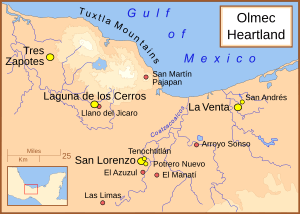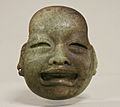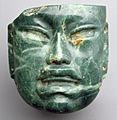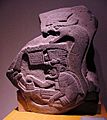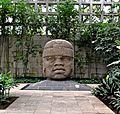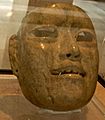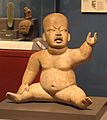Olmec facts for kids
The Olmec were an ancient people who lived about 3,000 years ago. They lived in what is now south-central Mexico. The Olmec were the first major civilization in an area called Mesoamerica. This region includes parts of modern-day Mexico and Central America. Many later civilizations in Mesoamerica learned from the Olmecs. They copied some of their ideas and ways of life.
The Olmec people used natural resources like rubber and corn. They also created huge stone heads. Archaeologists are still studying what these heads were for.
Contents
The Olmec Civilization
The Olmec civilization lasted from about 1200 BC to 400 BC. They had two main cities: first San Lorenzo Tenochtitlan and later La Venta. The Olmecs grew strong because of the rich, fertile land. This land was near the Coatzacoalcos river. No one knows exactly why the Olmec civilization ended.
Olmec Art and Sculptures
The Olmecs were skilled artists. They made many different kinds of art. This included stone altars, jade masks, and carvings.
Giant Stone Heads
The most famous Olmec artworks are their giant stone heads. These are known as the "colossal heads." They are a well-known symbol of the Olmec civilization. The heads are different sizes and weights. The largest one is about twice as tall as an average person.
Seventeen of these heads have been found. They were discovered in southern Mexican cities. These cities include La Venta, San Lorenzo Tenochtitlan, Tres Zapotes, and Rancho la Cobata. Each head has a unique face. They also wear a helmet with special designs. No two heads look exactly alike.
The purpose of these heads is a mystery. Scholars and archaeologists still wonder about their meaning.
How the Heads Were Made
Scholars have tried to figure out how the Olmecs made these huge objects. The heads were carved from a very hard rock called basalt. Archaeologists believe the Olmecs found most of this basalt in the Tuxtlas Mountain range.
One idea is that the Olmecs roughly shaped the heads in the mountains. Then, thousands of people either floated or dragged them. They moved the heavy stones from the mountains to the Olmec cities.
What the Heads Mean
The helmets on the sculptures are very important. They might give us a clue about what the heads mean. Rubber balls were found near some sculptures. This suggests that the Mesoamerican ball game might have started with the Olmecs. This ball game was a team sport. It was very important for the religion and culture of the native people of Mexico and Central America.
At first, people thought the heads showed ball players. They believed these players were sacrificed after losing a game. However, the most popular idea now is that the heads honor Olmec rulers.
Images for kids
-
Seated figurine; 12th–9th century BC; painted ceramic; height: 34 cm, width: 31.8 cm, depth: 14.6 cm; Metropolitan Museum of Art (New York City)
-
Bird-shaped vessel; 12th–9th century BC; ceramic with red ochre; height: 16.5 cm; Metropolitan Museum of Art
-
The back of Stela C from Tres Zapotes This is the second oldest Long Count date yet discovered. The numerals 7.16.6.16.18 translate to 3 September 32 BCE (Julian). The glyphs surrounding the date are one of the few surviving examples of Epi-Olmec script.
-
Olmec tomb at La Venta Park, Villahermosa, Tabasco.
-
Kunz Axe; 1000-400 BCE; jadeite; height: 31 cm (123⁄16 in.), width 16 cm (65⁄16 in.), 11 cm (45⁄16 in.); American Museum of Natural History (New York, NY, USA). The jade Kunz Axe, first described by George Kunz in 1890. Although shaped like an axe head, with an edge along the bottom, it is unlikely that this artifact was used except in ritual settings. At a height of 11 in (28 cm), it is one of the largest jade objects ever found in Mesoamerica.
-
Ornamental mask; 10th century BCE; serpentine; height: 9.2 cm, width: 7.9 cm, depth: 3.2 cm; Metropolitan Museum of Art (New York City)
-
Mask with cinnabar "tattoos"; c. 900-300 BCE; jadeite with cinnabar; Minneapolis Institute of Art (Minneapolis, US)
-
1200-400 BCE; polished green quartz (aventurine); height: 29 cm, width: 13.5 cm; British Museum (London)
-
800-400 BCE; serpentine, cinnabar; Dallas Museum of Art
-
The "twins" from El Azuzul, 1200–900 BCE
-
Olmec style bottle, reputedly from Las Bocas, 1100–800 BCE
-
Olmec-style painting from the Juxtlahuaca cave
See also
 In Spanish: Cultura olmeca para niños
In Spanish: Cultura olmeca para niños


